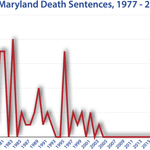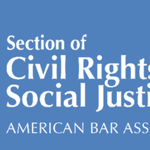
State & Federal
Maryland

History of the Death Penalty
The first execution in Maryland was that of four servants who were hung in 1773 for killing their master. The death penalty was re-evaluated in the early 1800’s, when the state established degrees of murder, allowing the death penalty only for individuals convicted of first degree murder. The death penalty was carried out by public hanging until 1913, when hangings were moved to a private space. About 50 years later, the gas chamber was briefly used as the primary method of execution, but only 4 individuals were executed that way. In 1994, lethal injection became the primary method of execution, starting with John Frederick Thanos, the first person to be executed in Maryland since 1961.
Notable Exonerations
Kirk Bloodsworth was the first death row prisoner to be exonerated based on DNA evidence. He was convicted in 1984 on charges that he had raped and murdered a 9‑year old girl. He spent 2 years on death row before being resentenced to life in prison. Throughout his almost nine years in prison, he insisted that he was “an innocent man” and signed all of his letters with that acronym, “A.I.M.” In 1993, Bloodsworth was exonerated when DNA testing on the semen found on the victim’s clothing excluded him as the killer. When he was released, the state compensated Bloodsworth $300,000 for the time he spent in prison. The compensation mostly went to cover legal expenses.
Notable Commutations/Clemencies
Eugene Colvin-el was sentenced to death for the brutal murder of 82-year old Lena Buckman. After exhausting his appeals process, there was only a month left until his execution was to be carried out. Then-Governor Parris Glendening commuted Colvin’s sentence to life in prison without parole despite the fact that he was “almost certain” that Colvin committed the crime. Glendening believed that being “almost certain” was not sufficient to justify a death sentence.
On January 20, 2015, Governor Martin O’Malley commuted the sentences of all four men remaining on Maryland’s death row to life in prison. The state’s abolition bill had not been retroactive, leaving 5 men under a sentence of death. One of the men died of natural causes before the remaining death sentences were commuted.
Milestones in Abolition/Reinstatement
In 1987, Maryland passed a law that prohibited juvelines from being sentenced to death and provided the option of life without parole for cases involving capital crimes.
In 1989, the state passed a provision banning the execution of intellectually disabled individuals.
In 2002, Governor Parris Glendening declared a moratorium on executions. The moratorium was lifted by his successor, Governor Robert Ehrlich.
In 2009, after nearly passing abolition legislation, Maryland instituted the tightest death penalty restrictions in the country. The law limited the death penalty to capital murder cases with biological or DNA evidence of guilt, a videotaped confession, or a videotape linking the defendant to a homicide.
Maryland’s legislature passed a death penalty repeal bill in March 2013. The bill was signed by Governor Martin O’Malley on May 2, 2013.
Other Interesting Facts
Since 1923, all of the prisoners executed in Maryland have been men.

Resources

Maryland Execution Totals Since 1976
News & Developments
News
Jul 08, 2025
ACLU Report Shows How Death Penalty Jury Selection Discriminates Against Black Americans, Women, and People of Faith
A new report from the ACLU documents how the process of selecting juries for death penalty cases systematically excludes Black prospective jurors, women, and people of faith, fundamentally undermining the constitutional promise of a trial by a jury of one’s peers. The report, Fatal Flaws: Revealing the Racial and Religious Gerrymandering of the Capital Jury, examines the practice of“death qualification,” a requirement that potential jurors must be…
Read MoreNews
Jun 28, 2023
First Death Row Exoneration Involving DNA Evidence Happened 30 Years Ago
June 28, 2023 marks the 30th anniversary of the exoneration of Kirk Bloodsworth (pictured), the first person exonerated from death row with DNA evidence. In the three decades since he was exonerated from Maryland’s death row, Mr. Bloodsworth has been a vocal advocate for criminal justice reform. He played an essential role in ending the death penalty in Maryland in 2013 and served as director of Witness to Innocence, an organization of death…
Read MoreNews
Feb 22, 2023
Former Maryland Death Row Prisoner Exonerated After 40 Years
John Huffington (pictured) has been exonerated of all the charges that sent him to death row over 40 years after his initial wrongful conviction. On January 13, 2023, outgoing Maryland Governor Larry Hogan granted a full pardon to Huffington, stating that evidence conclusively showed that his“convictions…
Read MoreNews
Oct 06, 2021
Death-Row Exoneree Kirk Bloodsworth Receives Supplemental Compensation Under New Maryland Wrongful Imprisonment Statute
Kirk Bloodsworth, the first former death-row prisoner to have been exonerated by DNA testing, has become the first person to receive supplemental compensation under a new Maryland wrongful imprisonment…
Read MoreNews
Jan 12, 2018
Experience Shows No “Parade of Horribles” Following Abolition of the Death Penalty
States that have recently abolished the death penalty have not experienced the“parade of horribles” — including increased murder rates — predicted by death-penalty proponents, according to death-penalty experts who participated in a panel discussion at the 2017 American Bar Association national meeting in New York City. Instead, the panelists said, abolition appears to have created opportunities to move forward with other broader…
Read More

